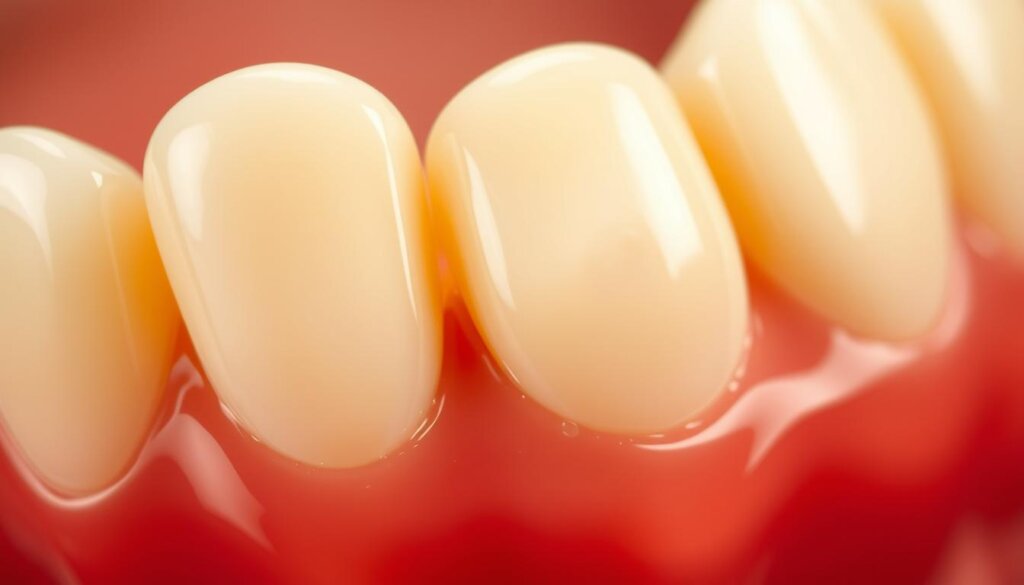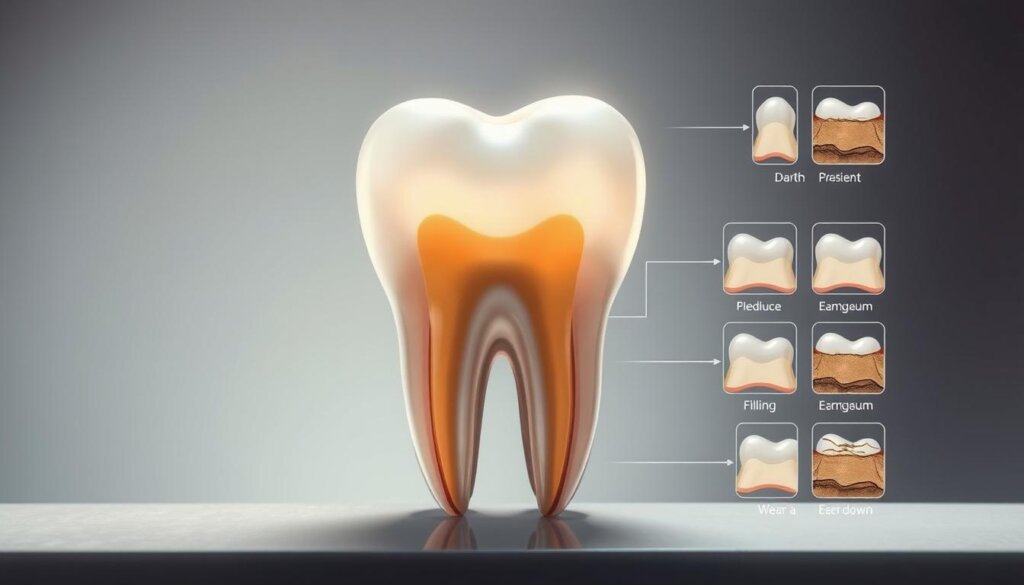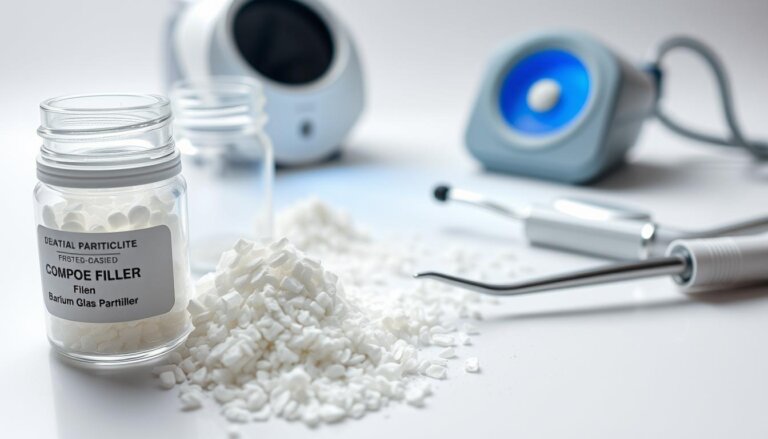What is a Tooth-Colored (Composite) Filling?
Did you know over 90% of adults have had tooth decay at some point? This shows how vital dental repairs are for oral health. The tooth-colored (composite) filling is a top choice. It not only fixes the tooth but also looks natural. Made from a special mix, it blends with your tooth color. This makes it hard to notice.
Tooth-colored fillings do more than just fill holes from decay. They make the tooth strong again. This helps keep your mouth healthy. Composite fillings are special because they stick right to your tooth. They’re tough and look just like your own teeth. Many people and dentists prefer them for these reasons.
Key Takeaways
- What is a tooth-colored (composite) filling? It’s a dental repair that looks and works like a real tooth.
- Dental caries is common, highlighting the need for good-looking and effective dental repairs.
- Composite fillings match your tooth color and are strong and lasting.
- These fillings stick to your tooth, supporting its structure and lessening breakage risks.
- Tooth-colored fillings show how dental technology and patient care have advanced.
Overview of Tooth-Colored Fillings
Dental fillings have changed a lot, leading to the creation of tooth-colored fillings. These are mostly made of a material called composite resin. They are good for fixing teeth and making them look nice because they match the color of your teeth well. Let’s take a closer look at composite fillings, their history, and why they matter in dentistry today.
Definition of Composite Fillings
Composite fillings, also known as tooth-colored fillings, are made from plastic resins and tiny glass particles. They are great for treating cavities because they last a long time and can be made to look just like your natural teeth. Besides fixing a tooth’s structure, they also make your smile look better.
History and Evolution of Dental Fillings
Over the years, tooth fillings have evolved a lot, moving from using materials like gold to composite resins. This change shows how dental materials have gotten better over time. It also shows that people now want fillings that work well and look good.
Importance of Aesthetics in Dentistry
Looks are very important in dentistry, especially when it comes to treatments like composite resin fillings. People now want treatments that not only fix their teeth but also make them look good. This shows how important it is to choose the right materials and treatments that look great.
In short, using composite resin fillings for cavities represents a big change in dentistry. This change focuses on both how fillings work and how they look. This balance makes patients happy and shows how composite fillings have become a key part of modern dentistry.
Composition of Composite Fillings
Learning about tooth-colored fillings helps us appreciate them more. They look and work like real teeth, thanks to smart engineering.
Key Ingredients Used in Composites
Composite fillings use plastic resins and silica fillers for strength and looks. The resins make them stick well, and the silica makes them strong. This mix helps fillings last long and blend in.
Types of Composite Materials
- Bis-GMA composites: They stand out for being really strong and shiny.
- Urethane dimethacrylate (UDMA): It’s flexible and tough, perfect for heavy chewing.
- Triethylene glycol dimethacrylate (TEGDMA): Chosen for great bonding and looks.
We pick the filling material based on where the tooth is and how much chewing it does.
Properties of Tooth-Colored Fillings
Composite fillings bond well with enamel. This bond helps fix cavities and makes teeth stronger. These fillings are also made to not break easily.
They also look like real teeth. This means they match the color and shine of your teeth, so fillings are not noticeable.
| Property | Description |
|---|---|
| Bonding Ability | Composite fillings can bond mechanically to tooth structure, allowing for conservative tooth preparation. |
| Fracture Resistance | Designed to withstand chewing forces, reducing the risk of failure under normal conditions. |
| Aesthetic Quality | Materials are customizable in color and translucency to match the natural tooth appearance. |
Dentists use composites to fix decayed or damaged teeth perfectly. They ensure the repair works well and looks good, keeping your smile bright and healthy.
Benefits of Tooth-Colored Fillings
Now we can fix teeth with fillings that look real and improve how we treat teeth. These fillings match the color of your tooth perfectly. They look good and work well.
Aesthetic Appeal
Composite fillings can be made to match the exact color of your teeth. This is great for the teeth that show when you smile. Dentists can tweak the colors to make sure they’re just right, keeping your smile looking natural.
Durability and Strength
These fillings are strong and can handle all the biting and chewing we do every day. They’re good for fixing both front and back teeth. What’s cool is they bond to your tooth, spreading out the pressure when you eat, which helps your tooth stay whole.
Minimally Invasive Treatment
Less of your tooth needs to be taken away with composite fillings than with metal ones. This method is easier on your tooth and helps the filling last longer. They grip onto your tooth well, making it stronger and more secure.
Drawbacks of Composite Fillings
Composite fillings look good, but there are downsides to think about. You should consider the cost of tooth colored filling cost, how long composite fillings last, and dental sensitivity after the procedure. Let’s look more closely at each.
Cost Considerations
Composite fillings cost more than the old silver ones. They need better materials and more care when being put in. It’s essential to see if your insurance will pay for them or if you’ll need to pay more yourself.
Potential Longevity Issues
People like how composite fillings look. But, they might not last as long as the silver ones. This might mean more trips to the dentist to get them fixed. How long they last can depend on where they are in your mouth and how you take care of your teeth.
Sensitivity After Placement
After getting a composite filling, your tooth might be sensitive to hot or cold. This discomfort usually gets better as your tooth gets used to the filling.
| Aspect | Composite Fillings | Amalgam Fillings |
|---|---|---|
| Initial Cost | Higher | Lower |
| Longevity | Potentially shorter | Longer |
| Post-Procedure Sensitivity | Common | Less common |
It’s key to know these drawbacks if you’re thinking about composite fillings. Consider these points along with the benefits to make a well-informed decision about your dental care.
The Procedure for Getting Composite Fillings
Starting to fix your tooth with a composite filling means learning about each step of the dental filling process. This procedure is carefully planned to fight tooth decay and make sure your filling lasts a long time.
A detailed dental check-up begins the process. This exam finds out how much decay there is and figures out the best way to fix it. The goal is to pick a treatment that matches your dental health needs perfectly.
Initial Consultation and Examination
The first step is a thorough check-up. The dentist uses advanced imaging to look at the tooth and surrounding area. They find decay and plan how to fix it well.
The Filling Application Process
To treat tooth decay, the dentist removes decayed parts and cleans the area. Then, they put in a tooth-colored composite. This material fills the cavity, making the tooth look and work right again.
Aftercare and Follow-Up
After the procedure, taking care of the filling is key. Patients learn how to keep it clean and when to come back for checks. This keeps the filling and teeth healthy.
Knowing these steps is important for patients. It helps ensure their dental work succeeds and lasts, which is a big part of today’s dentistry that aims for both looking good and working well.
| Stage | Description | Importance |
|---|---|---|
| Examination | Assessment of decay and oral health | Crucial for tailored treatment planning |
| Procedure | Removal of decay, application of composite | Directly addresses tooth decay and restores functionality |
| Aftercare | Guidance on oral hygiene, scheduled revisits | Ensures durability and health of the filling |
Comparing Tooth-Colored Fillings to Traditional Options
In the world of dentistry, choosing the right filling is key. It impacts not just how your smile looks but also how well your teeth work. Looking at tooth colored filling vs silver amalgam and porcelain restorations, we consider factors like look, lifespan, and cost.
Silver amalgam fillings have been around for a long time. They last long and are not expensive. But they are easy to see and need you to remove more of your tooth. On the other hand, tooth-colored composites look just like your teeth and don’t need as much tooth to be taken away. This helps save more of your natural tooth.
Porcelain restorations are another great choice for fillings that look good. They are strong and keep their color well, making them a lasting option that looks real. But, they can cost more, which some people need to think about.
When picking the right filling, think about these things:
- The location and extent of the decay
- The patient’s aesthetic preferences
- Overall costs involved
- Long-term durability needed
If you care a lot about looks and saving your tooth, tooth-colored composites or porcelain might be best. But if you need something strong and more affordable, amalgam fillings could still be a good choice.
Knowing about these dental filling options helps patients and dentists choose wisely. They can pick the best one for their dental health and what they like.
Maintenance of Tooth-Colored Fillings
Keeping tooth-colored fillings in good shape is key for oral health and their lasting effect. Proper dental restoration maintenance boosts how we chew and protects against future dental problems.
Good oral hygiene habits are crucial for these fillings’ care. It’s important to brush twice daily with fluoride toothpaste. This helps clean around the fillings to stop plaque and decay.
Flossing is a must to get rid of food bits and plaque where toothbrushes can’t, especially near the fillings’ edges.
- Daily Oral Hygiene Tips: Brush twice daily with fluoride toothpaste and floss once a day to remove plaque and food.
- Regular Dental Check-Ups: Visit your dentist every six months for checks and cleanings. This helps catch any filling issues early.
- Signs of Deterioration to Watch For: Look out for color changes, chipping, or sensitivity. See your dentist if these occur.
Going for dental check-ups regularly is vital. These visits include cleaning and checks on fillings’ condition. Catching issues like cracks early can extend fillings’ life.
Knowing when fillings are getting worse is important. Watch for color changes, new sensitivity, or cracks. Acting quickly when these signs show up can avoid bigger procedures later.
To sum up, caring for your oral health and seeing a dentist often are key for keeping tooth-colored fillings looking good. They help maintain dental health and a nice smile.
Lifespan of Composite Fillings
It’s key to know how long composite fillings last for patients and dentists. The quality of the material and the habits of the patient are important. We’ll look at tips to make fillings last longer and when you need to get them replaced.
Composite fillings can last a long time, sometimes up to 20 years. Their lifespan depends on where they are in your mouth and how big they need to be. But taking good care of them with regular dental visits helps them last longer.
| Factor | Impact on Lifespan |
|---|---|
| Placement in the mouth | Fillings in high-pressure areas like molars tend to have shorter lifespans. |
| Size of the filling | Larger fillings may fail quicker due to the greater impact of chewing forces. |
| Patient’s oral hygiene | Excellent oral hygiene can markedly extend filling longevity. |
| Regular dental check-ups | Frequent evaluations can help spot early signs of wear or damage. |
For longer lasting composite fillings, keep up with good oral hygiene. This means brushing and flossing daily. Also, avoid using your teeth as tools or grinding them. And don’t forget regular dentist visits for cleanings and check-ups. These steps are crucial for keeping your fillings in top shape.
Cost of Tooth-Colored Fillings
Understanding the tooth colored filling cost is key for anyone thinking about this dental choice. Composite fillings look good and are strong, fitting well with your teeth’s natural structure. It’s important to know about costs, including what dental insurance might cover and the overall value of composite fillings.
In the United States, the price of tooth-colored fillings varies. It depends on how complex the procedure is, the size of the filling, and where you live. Usually, these fillings cost more than regular amalgam ones because they use special materials and take more work to match your teeth’s color.
Dental insurance coverage for these fillings also differs a lot. Some plans may cover a big part of the cost, especially if it’s needed for health reasons, not just for looks. It’s smart to talk to your insurance company to know exactly what they will pay for. This way, you won’t be surprised by the bill.
When thinking about cost versus value of composite fillings, consider a few things:
- How long and how well the material lasts compared to other kinds.
- The way the fillings look and match with your own teeth.
- The health perks, like composite fillings not having mercury, which some old fillings have.
The initial tooth colored filling cost might be more, but the benefits and value can make it worth it over time. This is especially true for those who care about looks and using safe materials. Look at all these points carefully. Think about how getting these fillings will affect your teeth now and in the future.
Who Is a Good Candidate for Composite Fillings?
Figuring out who should get dental candidates composite fillings looks at many things from age to dental issues. These fillings look good and work well, which is why they’re liked in dentistry.
- Age ConsiderationsComposite fillings work well for all ages. For kids, they offer a strong fix for cavities in baby teeth. This helps save space for grown-up teeth. Adults benefit from them through better looks and teeth that work like they should after decay.
- Health and Dental HistoryHealth matters matter a lot when picking composite fillings. If you can’t take certain materials in other fillings, composites might be better. Your overall mouth health also affects what filling you can have. People with a lot of decay or weak teeth may need something tougher.
- Specific Dental ConditionsThe decay’s size, tooth’s spot, and chewing stress matter too. Composite fillings are great for teeth that everyone can see. They match your natural tooth color. So, they look good and work great too.
To sum up, finding the best candidates for composite fillings requires a full dental check. It makes sure the filling choice suits the person based on age-appropriate treatments and health considerations. Always talk to a skilled dental professional to find the best choice for your own tooth health.
Innovations in Composite Filling Technology
The future of dentistry is rapidly changing, especially in composite filling technology. This area of dental science is improving a lot. We’re seeing new materials, techniques, and ways to make patients happier. These changes make fillings last longer and work better.
Experts are working on new materials that are bioactive and look great. They want fillings to act more like real teeth. These new materials could even help keep teeth healthy.
The future of dentistry will include smart fillings. These fillings will do more than just fix teeth. They’ll help stop cavities from starting. The aim is to make the filling and the tooth work better together. This will help fillings last longer and look more natural.
| Current Materials | Future Materials | Benefits |
|---|---|---|
| Standard composite resins | Bioactive composite resins | Active participation in preventing decay |
| Color-matching aesthetics | Enhanced mimicking of natural tooth structure | Improved visual and functional outcomes |
| Durable polymers | Smart polymers with reactive capabilities | Greater longevity and durability |
These big changes will make fillings look better and last longer. It’s a big step for sustainable advancements in the dental field. Keeping patients happy and making dentistry better is what drives these changes.
Patient Experiences and Testimonials
Looking into composite fillings through real stories helps future patients understand the benefits. Dental patient stories show the good points of tooth-colored fillings. They tell about people’s experiences fixing their teeth, highlighting dental concerns and the professional recommendations that shaped their choices.
Real-Life Success Stories
- Patients often talk about how well composite fillings match their natural teeth, improving their smiles and confidence.
- They are pleased with how well the fillings work, making eating and talking easy again.
Common Concerns and Solutions
Sometimes, patients worry about sensitivity after getting fillings. Dental concerns like these are carefully handled by dentists. They suggest special toothpastes and give tips for getting used to the new fillings.
Recommendations from Dentists
Dentists are key in turning worries into learning moments by giving professional recommendations. They talk about the best materials and how to put in fillings correctly. They also plan how to take care of the fillings for them to last longer, helping keep mouths healthy.
Many dental patient stories and professional recommendations from dentists show the success of composite fillings. This makes them a top choice for those wanting better looking and working teeth.
Frequently Asked Questions About Composite Fillings
Composite fillings are a go-to for fixing teeth damaged by decay. We aim to answer common questions about their safety, how we spot decay, and what to expect when recovering from a filling.
Are Composite Fillings safe?
The safety of dental fillings worries many people thinking about composite fillings. But don’t fret! Lots of research shows they’re safe. The materials are friendly to our bodies and follow tough safety rules. They’re designed to fix teeth without causing harm.
How do I know if I need a filling?
Spotting tooth decay early stops worse damage. Signs you might need a check-up include holes or pits in teeth, tooth pain or feeling things more, and changes in tooth color. Dentists can find decay by looking and using special pictures, suggesting a composite filling if needed.
What to expect during recovery?
The filling recovery process is mostly easy, letting most people stick to their daily stuff. After getting a filling, some feel a bit sensitive or uncomfortable, but it goes away quickly. Following your dentist’s advice, like not having very hot or cold drinks and not chewing hard stuff, helps your filling settle in smoothly.
Conclusion: The Role of Tooth-Colored Fillings in Modern Dentistry
Tooth-colored fillings play a key role in today’s dental care. They change how dentists fix tooth decay and damage. Unlike old metal fillings, these newer options blend in, making sure smiles stay bright and natural.
Choosing fillings now means looking at health, look, and lasting quality. More people pick composite fillings because they meet health needs and look good. This change shows how modern dentistry not only focuses on fixing teeth but also on meeting people’s expectations.
Deciding on composite fillings involves talks with your dentist about what’s best for you. They consider your oral health history and what you need for the future. With composite fillings, dentistry is improving, combining life’s demands with the need for a healthy smile.






